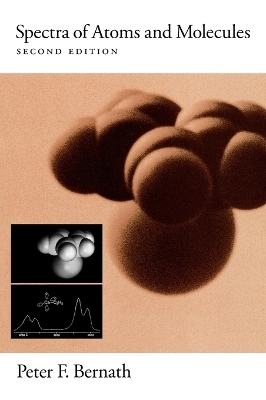
Spectra of Atoms and Molecules
Oxford University Press Inc (Verlag)
978-0-19-517759-6 (ISBN)
- Titel ist leider vergriffen;
keine Neuauflage - Artikel merken
Spectra of Atoms and Molecules, 2nd Edition is designed to introduce advanced undergraduates and new graduate students to the vast field of spectroscopy. Of interest to chemists, physicists, astronomers, atmospheric scientists, and engineers, it emphasizes the fundamental principles of spectroscopy with its primary goal being to teach students how to interpret spectra. The book includes a clear presentation of group theory needed for understanding the material and a
large number of excellent problems are found at the end of each chapter. In keeping with the visual aspects of the course, the author provides a large number of diagrams and spectra specifically recorded for this book. Topics such as molecular symmetry, matrix representation of groups, quantum
mechanics, and group theory are discussed. Analyses are made of atomic, rotational, vibrational, and electronic spectra. Spectra of Atoms and Molecules, 2nd Edition has been updated to include the 1998 revision of physical constants, and conforms more closely to the recommended practice for the use of symbols and units. This new edition has also added material pertaining to line intensities, which can be confusing due to the dozens of different units used to report line and band strengths.
Another major change is in author Peter Bernath's discussion of the Raman effect and light scattering, where the standard theoretical treatment is now included. Aimed at new students of spectroscopy regardless of their background, Spectra of Atoms and Molecules will help demystify spectroscopy by showing
the necessary steps in a derivation.
1. Introduction 1.1-Waves, Particles, and Units 1.2-The Electromagnetic Spectrum 1.3-Interaction of Radiation with Matter 2. Molecular Symmetry 2.1-Symmetry Operations 2.2-Groups 2.3-Notation for Point Groups 3. Matrix Representation of Groups 3.1-Vectors and Matrices 3.2-Symmetry Operations and Position Vectors 3.3-Symmetry Operators and Basis Vectors 3.4-Symmetry Operators and Basis Fuctions 3.5-Equivalent, Reducible, and Irreducible Matrix Representations
3.6-Great Orthogonality Theorem 3.7-Character Tablesity Theorem 4. Quantum Mechanics and Group Theory 4.1-Matrix Representation of the Schrödinger Equation 4.2-Born-Oppenheimer Approximationchrödinger Equation 4.3-Symmetry of the Hamiltonianionchrödinger Equation 4.4-Projection Operatorsltonianion 4.5-Direct
Product Representations 4.6-Integrals and Selection Ruless 5. Atomic Spectroscopyction Ruless 5.1-Introductionoscopyction Rules 5.2-Angular Momentumpy 5.3-The Hydrogen Atom and One-Electron Spectra 5.4-Many-Electron Atomsnd One-Electron Spectra 5.5-Selection Rulestomsnd One-Electron Spectra 5.6-Atomic Spectrastoms 5.7-Intensity of Atomic Lines 5.8-Zeeman EffectAtomic Lines 5.9-Stark EffecttAtomic Lines 6. Rotational Spectroscopy 6.1-Rotation of Rigid Bodies 6.2-Pure Rotational Spectroscopy of
Diatomic and Linear Molecules 6.3-Intensity of Pure Rotational Transitions of Diatomic and Linear Molecules 6.4-Symmetric Tops 6.5-Asymmetric Topsre Rotational Transitions of Diatomic and 6.6-Structure Determination 7. Vibrational Spectroscopy 7.1-Diatomic MoleculesRotational Transitions of Diatomic
and 7.2-Vibrational Motion of Polyatomic Molecules 7.3-Vibrational Spectra of Symmetric Tops 7.4-Infrared Transitions of Spherical Tops 7.5-Vibrational Spectra of Asymmetric Topsules 7.6-Vibration-Rotation Line Intensitiesps 7.7-Fermi and Coriolis Perturbationsl Tops 7.8-Inversion Doubling and Fluxional Behaviors 8. The Raman Effection Line Intensitiesps 8.1-BackgroundCoriolis Perturbationsl Tops 8.2-Rotational Raman EffectFluxional Behavior 8.3-Vibration-Rotation Raman Spectroscopy
8.4-Rayleigh and Raman Intensitiesns 8.5—Conclusionsaman Effect 9. Electronic Spectroscopy of Diatomic Molecules 9.1-Orbitals and StatesIntensities 9.2-Vibrational Structure 9.3-Rotational Structure of Electronic Transitions of Diatomic Molecules 9.4-The Symmetry of Diatomic Energy Levels: Parity
9.5-Rotational Line Intensities 9.6-Dissociation, Photodissociation, and Predissociation 10. Electronic Spectroscopy of Polyatomic Molecules 10.1-Orbitals and Statesomic Energy Levels: Parity 10.2-Vibrational Structure of Electronic Transitions 10.3-Vibronic Coupling: The Herzberg-Teller Effect 10.4-Jahn-Teller Effect 10.5-Renner-Teller Effect 10.6-Nonradiative Transitions: Jablonski Diagram 10.7-Photoelectron Spectroscopy 10.8-Rotational Structure: H2CO and HCN 10.9-Intensity of Transitions
11. Appendix A: Units, Conversions, and Physical Constants 12. Appendix B: Character Tables 13. Appendix C: Direct Product Tables 14. Appendix D: Introductory Textbooks Covering All of Spectroscopy 9.6-Dissociation, Photodissociation, and Predissociation
| Erscheint lt. Verlag | 19.5.2005 |
|---|---|
| Zusatzinfo | Line drawings throughout |
| Verlagsort | New York |
| Sprache | englisch |
| Maße | 181 x 262 mm |
| Gewicht | 1003 g |
| Themenwelt | Naturwissenschaften ► Chemie ► Analytische Chemie |
| Naturwissenschaften ► Physik / Astronomie ► Atom- / Kern- / Molekularphysik | |
| ISBN-10 | 0-19-517759-2 / 0195177592 |
| ISBN-13 | 978-0-19-517759-6 / 9780195177596 |
| Zustand | Neuware |
| Informationen gemäß Produktsicherheitsverordnung (GPSR) | |
| Haben Sie eine Frage zum Produkt? |
aus dem Bereich


